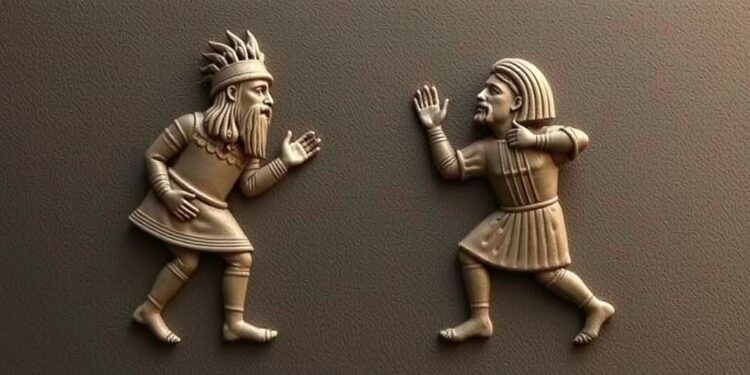ITHACA, N.Y. – The field of Middle Eastern archaeology and linguistics is witnessing an unprecedented technological evolution, thanks to the recent developments in artificial intelligence. Researchers from Cornell University, in collaboration with Tel Aviv University (TAU), have unveiled a groundbreaking approach known as ProtoSnap. This innovative technology is set to transform the way scholars interpret and reproduce cuneiform writing, which comprises one of the earliest known forms of writing and encompasses a diverse array of characters.
Cuneiform, originating in ancient Mesopotamia, encompasses over 1,000 unique symbols that were utilized to record various aspects of society, including administrative records, literary texts, and personal correspondence. The characters are notoriously challenging to decipher due to the significant variations that arise across different cultures, historical periods, and even individual scribes. These discrepancies contribute to the complex and often ambiguous nature of cuneiform texts, complicating efforts to translate and understand them fully.
In recognition of these challenges, the ProtoSnap technique employs sophisticated machine learning algorithms adept at understanding complex visual patterns. The core idea behind ProtoSnap involves capturing the essence of a character and aligning it with the variations that appear in ancient tablets. This process begins with a prototype character—a digital representation of a cuneiform symbol—which is then matched with the character as it appears on the tablet. By leveraging a diffusion model, a type of generative AI often used in computer vision applications, researchers can analyze each pixel in the image to discern similarities and align the prototype accordingly.
The promise of ProtoSnap lies in its ability to not only enhance deciphering accuracy but also to automate the labor-intensive process of copying cuneiform tablets. Traditionally, this task demands immense skill and can take scholars countless hours to accomplish for a limited number of texts. With ProtoSnap, experts can rapidly create high-fidelity copies of cuneiform characters, empowering them to focus on broader scholarly analysis rather than the minutiae of transcription.
Furthermore, the researchers elucidate how the aligned prototypes can effectively be utilized for training downstream models in optical character recognition (OCR). This is a pivotal step in transforming images of cuneiform tablets into machine-readable text. By training these AI models with data generated from ProtoSnap, the team has demonstrated a remarkable enhancement in recognizing cuneiform characters, even those that are rare or heavily stylized. The implications of this advancement extend beyond mere transcription, offering the ability to conduct large-scale comparisons of texts across various timelines, locations, and writing styles.
A key component of this research is the underlying challenge posed by the scarcity of labeled data for cuneiform inscriptions. While numerous 2D scans of cuneiform tablets exist in museums, the amount of curated data that can be utilized for training AI algorithms remains significantly limited. This shortage has historically stymied efforts to leverage machine learning effectively in this area of scholarship, underscoring the critical nature of the ProtoSnap technology in addressing these limitations.
As the landscape of historical linguistics continues to evolve, the integration of artificial intelligence signifies a paradigm shift. The intersection of machine learning and ancient historical study opens a plethora of new research avenues. Scholars can now anticipate a future where vast libraries of cuneiform texts can be systematically cataloged, analyzed, and presented, leading to new insights into ancient societies and their interactions.
In an era where digitization is becoming increasingly commonplace, the benefits of this research extend far beyond the boundaries of academia. The outcomes promise to make ancient languages and scripts more accessible to a broader audience, enhancing both public understanding and appreciation of early human civilization. Educational institutions, museums, and digital platforms may soon wield these AI tools to engage the public in ways previously unimagined, inviting them to explore the enigmatic world of ancient writing.
The upcoming presentation of Rachel Mikulinsky—one of the co-authors of the ProtoSnap research—at the International Conference on Learning Representations (ICLR) will serve as a vital dissemination point for these findings. Scholars and enthusiasts alike are eager to witness the ongoing dialogue on how AI can reshape historical studies, fostering collaboration and innovation in unforeseen ways.
Such advancements in the decoding of ancient scripts reaffirms the importance of interdisciplinary collaboration in solving complex problems. The melding of humanities and computer science, as exemplified by the collective effort of researchers from TAU and Cornell, not only enriches the academic discourse but also exemplifies the modern scholar’s toolkit where technology plays an enhancing role.
The research conducted under the auspices of the TAU Center for Artificial Intelligence & Data Science, along with funding from the LMU-TAU Research Cooperation Program, underscores the critical importance of investment in interdisciplinary studies. The success of ProtoSnap serves as a powerful testament to what can be achieved when diverse fields converge, yielding results that have the potential to redefine long-established academic norms.
In summary, the unveiling of ProtoSnap embodies a significant milestone in the study of cuneiform writing. By leveraging state-of-the-art AI technologies, scholars are poised to unlock the secrets embedded within thousands of years of history, transforming our understanding of early civilizations and their complex societies. As we stand on the cusp of this new frontier, the collaboration between artificial intelligence and humanities reminds us that the quest for knowledge is a continuous voyage, forever enhanced by innovation and creativity.
Subject of Research: Transforming Cuneiform Decipherment with AI
Article Title: ProtoSnap: Prototype Alignment for Cuneiform Signs
News Publication Date: October 2023
Web References: Link to original article
References: [Additional academic references can be mentioned here]
Image Credits: Research Team, Cornell University
Keywords
AI in Humanities, Cuneiform Decipherment, Optical Character Recognition, Machine Learning in Archaeology.
Tags: advancements in archaeological methodsAI in archaeologyancient Mesopotamian scriptscuneiform character variationscuneiform writing technologydeciphering historical textsdigitizing ancient languagesinterdisciplinary collaboration in researchmachine learning in linguisticsProtoSnap techniquetransforming linguistics with AIvisual pattern recognition in AI





